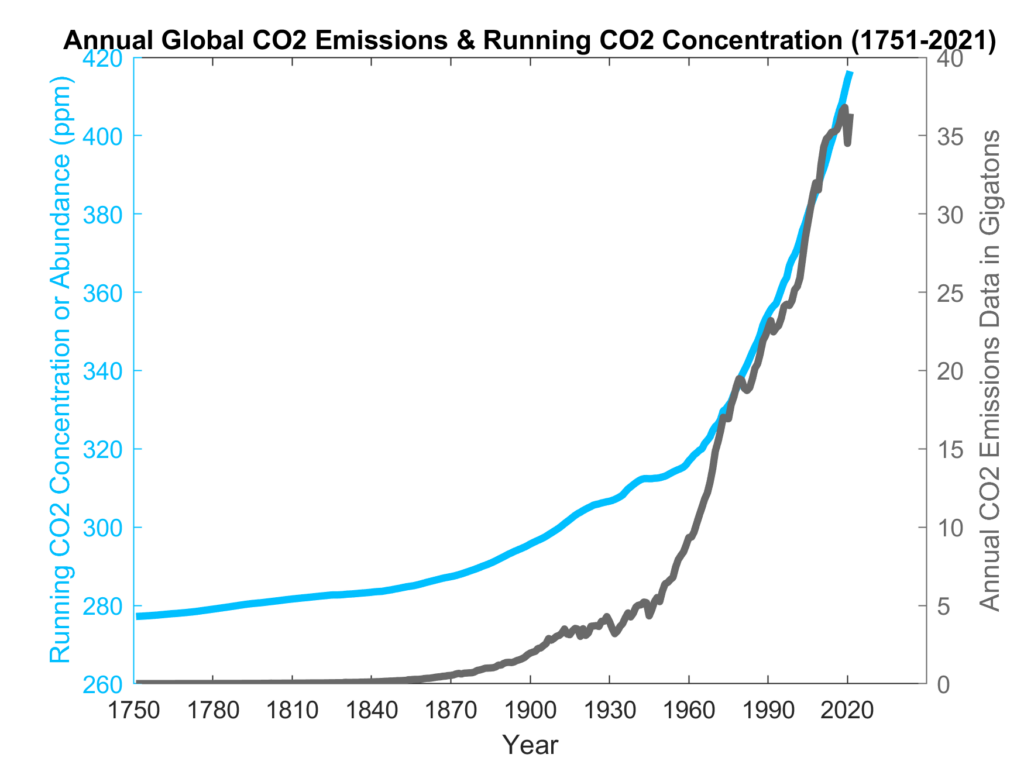
The Story of Climate Change
May 9th, 2023
According to Climate.gov, the earth’s temperature is rising, and this could be a big problem. Earth’s temperature has risen by an average of 0.14° Fahrenheit (0.08° Celsius) per decade.
Since 1880, or about 2° F in total, the rate of warming since 1981 has been more than twice as fast: 0.32° F (0.18° C) per decade.” The world is getting hotter, and it is getting hotter at a faster and faster rate. According to Howard Diamond, a Climate Science Program Manager at NOAA’s Air Resources Laboratory, people are to blame. “Nearly two hundred years of research that has built up that has looked at many things that might be the cause of climate change, but all the scientific evidence points unequivocally to greenhouse gases, primarily carbon dioxide (CO2) as the primary forcing agent or driving force behind rising global temperatures” he said in an email interview. Diamond says, the world is getting hotter, it is affecting the weather, people’s mental and physical health and it is causing the sea levels to rise.
Well, while no climate scientist necessarily blames every extreme event on climate change, there is no doubt that a warmer planet is having effects on changing weather patterns and in producing more extreme events.
Howard diamond

Diamond said while climate change is not the main reason for all the severe weather that occurs, he said that there is no doubt that climate change is having some kind of effect. “Well, while no climate scientist necessarily blames every extreme event on climate change, there is no doubt that a warmer planet is having effects on changing weather patterns and in producing more extreme events.” he said. He added that not all natural disasters can be blamed on climate change either.
“From a science standpoint, and with respect to climate change and hurricanes, scientists have always urged caution and indicated that the jury is still out on that,” he said.” Many papers and models indicate that we could see a lower frequency of storms yet stronger ones.”
“You know, warming of climate change might include increased malaria transmission or increased pathogens in water supplies.”
Mark Lynas
Climate change can also impact other aspects of life other than weather. Mark Lynas, author and co-founder of the pro-science environmental campaign network, Replant, says diseases can also increase. “You know, warming of climate change might include increased malaria transmission or increased pathogens in water supplies.” Lynas said this scenario is based on how developed the country is and would impact less developed countries more.
However, that is not to say that the more developed countries would not see some effects as well. According to the EPA, health effects of climate change include respiratory and heart diseases, pest-related diseases like Lyme disease and West Nile Virus, water- and food-related illnesses, and injuries and deaths.
Climate change has been linked to increases in violent crime and overall poor mental health. Climate change can have a significant impact on people’s mental health, including increased anxiety, depression, and post-traumatic stress disorder. Natural disasters, such as hurricanes, floods, and wildfires, can also lead to trauma and mental health issues. Climate change can also lead to displacement and loss of homes and communities, which can have long-lasting effects on mental health. By addressing climate change, we can help to mitigate these negative effects and create a healthier, more resilient society.
The EPA says there are three characteristics that would make someone more vulnerable to the effects of climate change. Exposure being the first one, including how long you are subjected to whatever change may be happening. The second one is sensitivity, which means older people and those with health conditions would be more likely to be affected. Third, adaptive capacity, which describes someone’s ability to adapt to their surroundings and manage them.
According to many leading scientists, the world is getting hotter, it is rising at 0.32° F (0.18° C) per decade. “Some models expect that by the end of this Century that we could see an average annual temperature that is as much as 6ºC (10.8ºF) higher than the 20th Century long-term average.” Diamond explained.
Diamond says this is an average value, so there will be locations that will feel it more than others, and in different ways, even to the point that some places are uninhabitable. “With averages that high, it is possible that large areas of the tropical and equatorial regions of the world may become inhabitable for people to live in.”
He added that some places could also become wetter, as precipitation increases, places to disappear altogether “Sea levels will definitely be higher, and the coastal cities around the world could be in for some significant inundation, while some low-lying atoll island states in the Indian Ocean (e.g., Maldives) and Pacific (e.g., Kiribati) are in great danger of disappearing,” he said.
Charron added that meaningful change will require the public to advocate for it from public officials. “Also, you can start calling out bad actors, whether those bad actors are governments or there’s bad actors or corporations, “he said. Individual action is one of the most important ways to get involved and start mitigating the risk of climate change.”
Are the sea levels rising? Tyler Wittkofsky, a NOAA Affiliate specialist in the rising sea level area, was able to provide some answers to this question. “Globally it is due to land-based ice melting of glaciers in Greenland Antarctic ice sheets. That is about two thirds of the global signal with the other third being warming of the ocean thermal expansion of the ocean.”
“Globally it is due to land-based ice melting of glaciers in Greenland Antarctic ice sheets. That is about two thirds of the global signal with the other third being warming of the ocean thermal expansion of the ocean.”
tyler wittkofsky
When asked about what is the biggest reason for the rise in sea levels Wittkofsky had this to say “Oh, greenhouse gas emissions, primarily higher emissions than there are other things. Methane contributes water vapor, but they are shorter lived in the atmosphere. Carbon dioxide resides for hundreds of years, even 1000s in terms of its equilibrium state.” Wittkofsky would go on to explain how these would cause the temperature to rise and thus make it so that the glaciers would be more likely to melt, and thus would mean that the water would rise and would then mean that some of the land mass would shrink. Some of the places that would be most likely to face the shrinking land mass would be the coastal cities or islands.
There are ways that the everyday person can help improve the situation of the planet. Aidan Charron is the End of Plastics Coordinator from earthday.org, an organization that has partnered with multiple other organizations to try and stop the destruction of the earth, and talked about how if we don’t try to stop our global footprints from getting so big, then only one group of people will thrive, “The only people that are going to be able to thrive on this planet and live are going to be extremely wealthy.” He says there are a number of ways to help decrease climate change. “Ride your bike as opposed to public transportation. Anything you can do to reduce your global emissions footprint,” he said.
“The only people that are going to be able to thrive on this planet and live are going to be extremely wealthy.”
Aidan Charron
Of course, there are other ways that you can help decrease climate change, such as driving less, eating less meat, using energy-efficient appliances, and reducing water consumption. Another way to reduce your carbon footprint is to use public transportation or carpool whenever possible. By taking small steps to reduce your carbon footprint, you can help to create a more sustainable world for future generations.
Climate change is a complex and multifaceted issue that requires immediate and sustained action from all of us. We need to reduce our carbon footprint, invest in renewable energy sources, and work together to create a more sustainable future. By acting now, we can help to mitigate the worst effects of climate change and create a better world for future generations.



